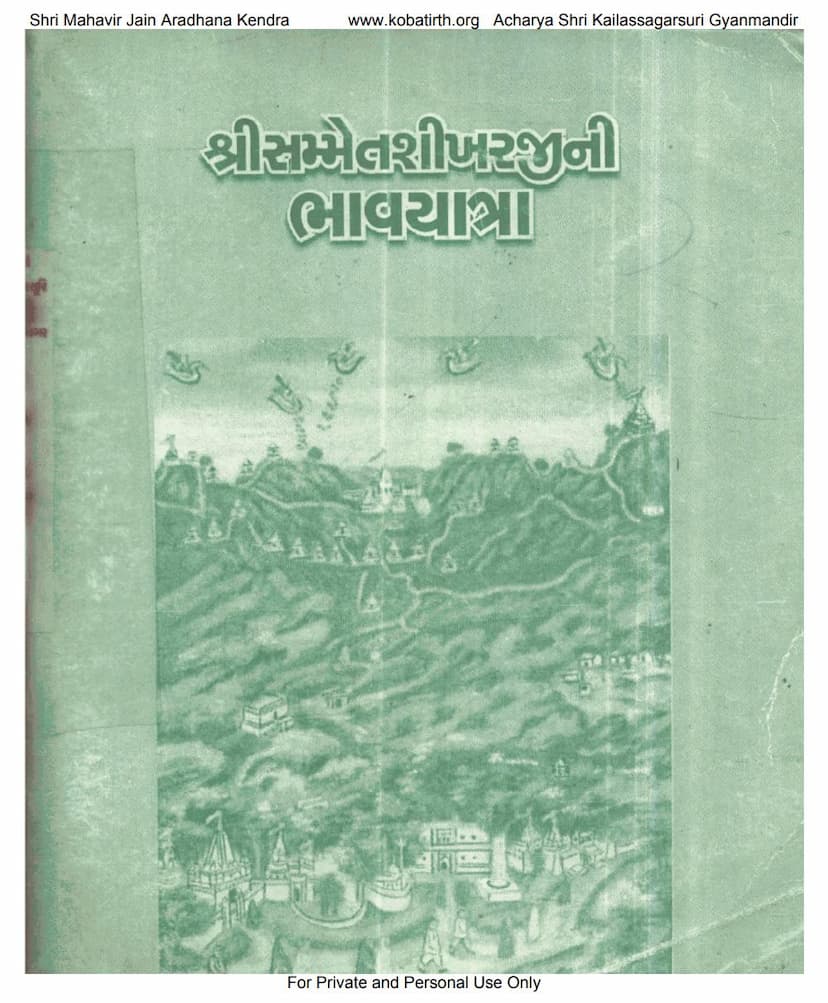Sammetshikharjini Bhav Yatra
Added to library: September 2, 2025

Summary
Here's a comprehensive summary of the Jain text "Sammetshikharjini Bhav Yatra":
Book Title: Sammetshikharjini Bhav Yatra (A Devotional Journey to Sammetshikharji) Author: Harchand Khetsibhai Vora Publisher: Harchand Khetsibhai Vora (Published by Parshva Publication, Ahmedabad) Year of Publication: 2001
Overview:
"Sammetshikharjini Bhav Yatra" is a devotional guide that takes the reader on a spiritual journey to Sammetshikharji, one of the most sacred pilgrimage sites in Jainism. The book is presented as a "Bhav Yatra" (a journey of the mind and spirit), aiming to evoke the feeling of being physically present at the holy sites through vivid descriptions and devotional songs (stanzas). The journey is undertaken under the spiritual guidance of Acharya Shri Jayantsen Suri Maharaj Saheb and his disciples, specifically Shri Swayamprabha Shreeji Maharajsaheb and Shri Kanak Prabha Shreeji Maharajsaheb.
Key Themes and Content:
The book is structured as a guided pilgrimage, starting with an invocation and leading the reader through various holy places associated with the Tirthankaras, primarily in the region of Sammetshikharji and surrounding areas. The core of the text involves:
-
The Importance of Tirth Yatra: The book emphasizes the immense spiritual merit and benefits gained from visiting holy places, even through mere remembrance or mental visualization. It highlights that visiting these sites can lead to the shedding of karma and spiritual advancement.
-
Spiritual Journey: The "Bhav Yatra" is designed to be an immersive experience. Readers are encouraged to close their eyes, listen to the descriptions, and imagine themselves participating in a grand procession with a large congregation, filled with devotion and religious songs.
-
Key Pilgrimage Sites and Tirthankaras: The journey covers numerous significant sites, often detailing the birth, renunciation, or enlightenment of specific Tirthankaras. Some of the prominent locations and Tirthankaras mentioned include:
- Shri Munisuvrat Swami: The journey begins with a visit to a temple dedicated to Munisuvrat Swami, seeking his blessings for a smooth pilgrimage.
- Varanasi (Bhelupur): The birthplace of Lord Parshvanath, where the ancient idol of Shri Shamlaji Parshvanath is described.
- Ganges Ghat: A site associated with Lord Parshvanath's miraculous intervention to save the snake king Dharanendra.
- Bhadaini: The birthplace of Lord Suparshvanath, where all four of his auspicious events (life-impulse, birth, renunciation, omniscience) occurred.
- Sinhpuri: The birthplace of Lord Shreyanshnath, where his four auspicious events took place.
- Chandrapuri: The birthplace of Lord Chandraprabh Swami, blessed by his four auspicious events.
- Patna: Visiting sites related to historical figures like Sudarshan Sheth and the footprints of Sthulabhadra.
- Kundalpur: The birthplace of Lord Mahavir's biological parents and the village of his first spiritual teacher, Gautam Swami.
- Nalanda: Another significant site with ancient idols and footprints of Gautam Swami.
- Rajgruhi: Featuring temples of Lord Munisuvrat Swami and describing the five sacred mountains (Vipulachal, Ratnagiri, Udaygiri, Suvarnagiri, Vaibharagiri) with their respective Tirthankara footprints and historical significance.
- Pawapuri: The site of Lord Mahavir's nirvana, focusing on the Jal Mandir and the divine atmosphere.
- Guniya Ji: The place where Lord Mahavir spent his Chaturmas and where Gautam Swami attained omniscience and nirvana.
- Kshatriyakund: The birthplace and place of renunciation of Lord Mahavir.
- Rijubalika River (Barakar): The site where Lord Mahavir attained omniscience.
- Sammetshikharji (Main Destination): The spiritual climax of the journey involves ascending the holy mountain, visiting the various "Tunks" (peaks or spots) associated with the 20 Tirthankaras who attained nirvana there. The book meticulously describes the ascent, the various Tirthankara Tunkas (e.g., Abhinandan Swami's Tunk, Vasupujya Swami's Tunk, Sambhavnath's Tunk, Sheetalnath's Tunk, Anantnath's Tunk, Adinath's Tunk, Chandaprabha's Tunk, Munisuvrat Swami's Tunk, Padmaprabha's Tunk, Suvidhinath's Tunk, Shreyanshnath's Tunk, Mallinath's Tunk, Aranath's Tunk, Naminath's Tunk, Kunthunath's Tunk, Dharmanath's Tunk, Parshvanath's Tunk, Sumatinath's Tunk, Ajitnath's Tunk, Neminath's Tunk), the associated legends, the immense spiritual merit of their pilgrimage, and the devotional songs sung at each site.
-
Devotional Songs and Prayers (Stutis & Stavans): Throughout the journey, the book incorporates numerous devotional songs, hymns, and prayers dedicated to the Tirthankaras and specific holy sites. These are intended to enhance the spiritual experience and connect the reader with the divine.
-
The Significance of Sammetshikharji: The text specifically highlights the unparalleled importance of Sammetshikharji, mentioning that 20 Tirthankaras attained liberation there. It describes the arduous yet rewarding journey up the mountain, the various Tunkas, and the immense spiritual benefit of circumambulating them.
-
Role of Gurus: The book emphasizes the role of spiritual teachers (Gurus) in guiding devotees and providing the spiritual insight needed to appreciate the significance of the pilgrimage. The lineage of Acharyas is mentioned, highlighting their blessings and guidance.
-
Family Sponsorship: The publication of the book is attributed to the Vora Harchand Khetsibhai family, who undertook this spiritual journey on September 9, 2001, to fulfill their wishes and contribute to the Sangh's spiritual endeavors.
Purpose and Usage:
"Sammetshikharjini Bhav Yatra" serves as a guide for Jain devotees, both for those who can undertake the physical pilgrimage and for those who wish to experience it spiritually from afar. It aims to deepen understanding of Jain history, Tirthankaras, and the profound spiritual significance of Sammetshikharji, encouraging devotion and merit accumulation. The phrase "For Private and Personal Use Only" indicates its intended audience and personal devotional nature.
In essence, the book is a detailed spiritual itinerary, enriched with historical anecdotes, devotional poetry, and the guiding presence of revered Jain monks, all orchestrated to evoke a profound sense of connection to the sacred land of Sammetshikharji.